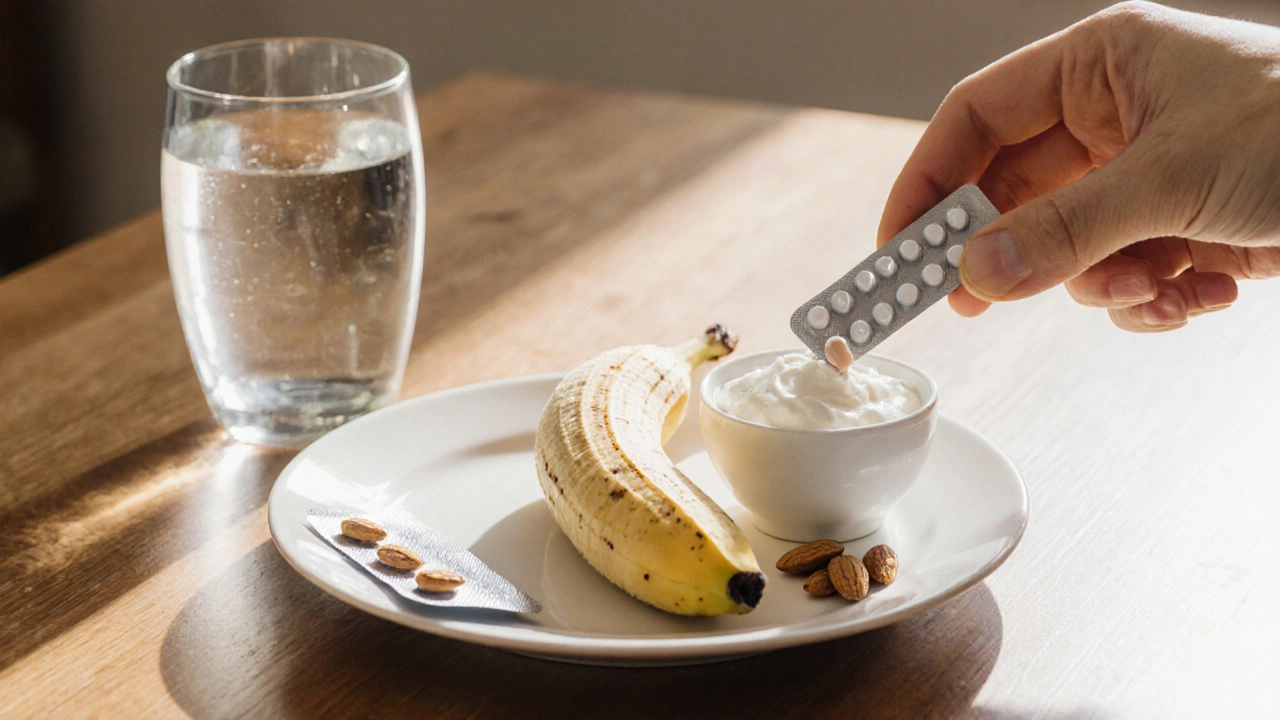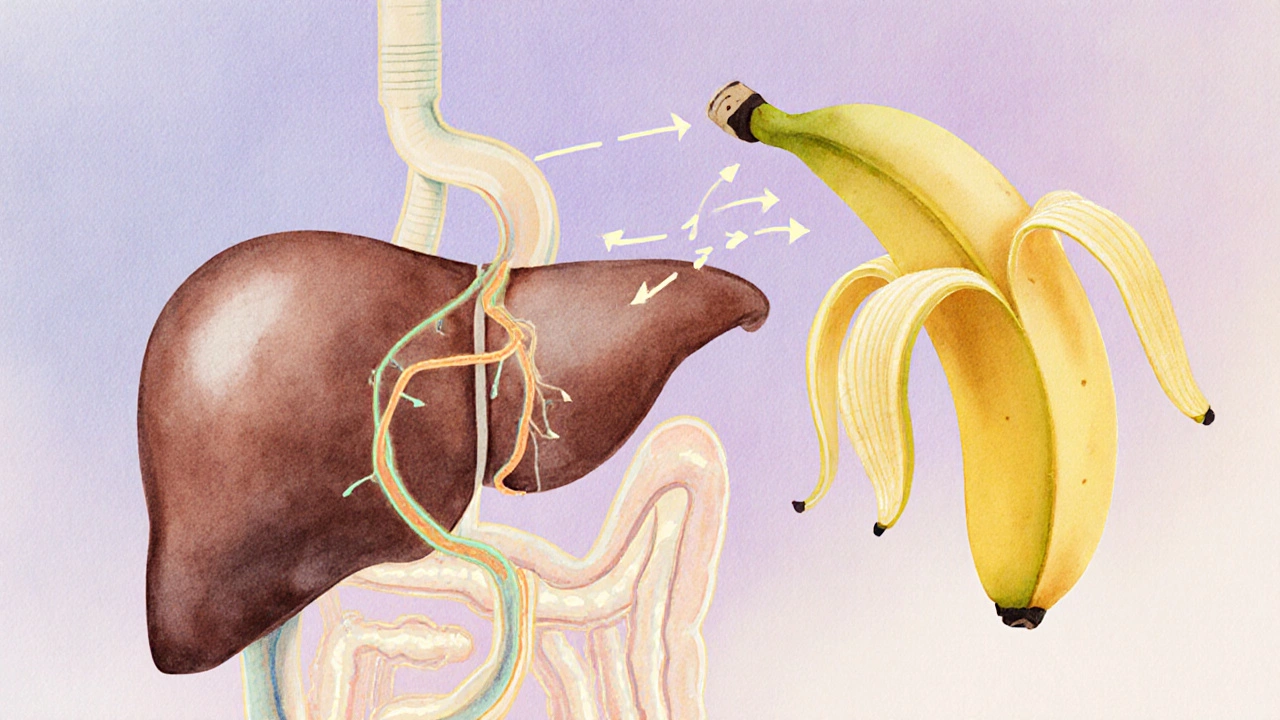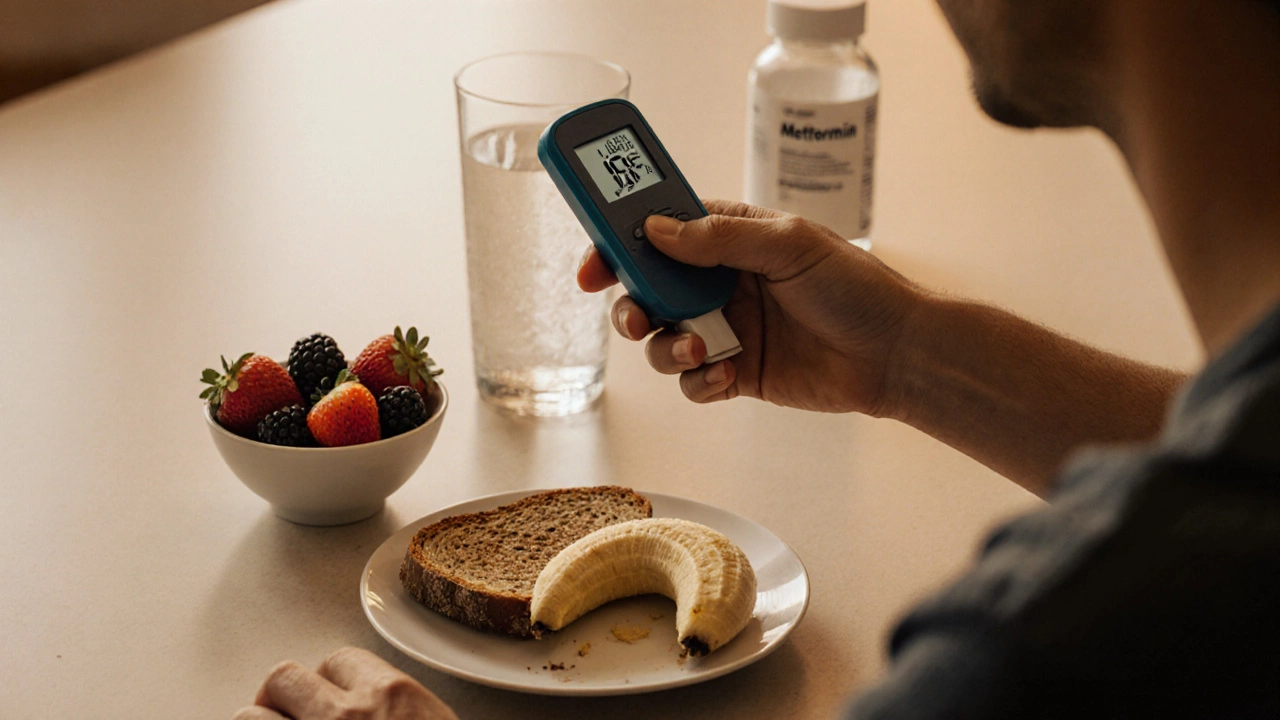-
8

Bananas and Metformin: Safe Pairing for Diabetes?
Banana & Metformin Interaction Checker
Nutritional Comparison
Banana
GI: 51
Fiber: 2.6g
Potassium: 358mg
Carbs: 27g
Strawberry
GI: 40
Fiber: 2.0g
Potassium: 153mg
Carbs: 7.7g
Apple
GI: 38
Fiber: 2.4g
Potassium: 107mg
Carbs: 13.8g
Key Takeaways
- Bananas don’t neutralize the blood‑sugar‑lowering effect of metformin banana interaction, but their natural sugars can raise glucose levels if you over‑eat.
- The fruit’s glycemic index (GI) sits around 51, so a moderate portion fits most metformin‑based plans.
- Take metformin with meals; eating a banana at the same time helps reduce stomach upset.
- Watch kidney function and blood‑glucose trends, especially if you add large banana portions.
- Other low‑GI fruits (berries, apples) are good alternatives when you need variety.
How Metformin Works
Metformin is the first‑line oral drug for Diabetes mellitus type 2. It lowers blood glucose by reducing liver‑produced glucose, improving insulin sensitivity, and slowing carbohydrate absorption in the gut. Because it acts mainly on the liver, the drug’s effect isn’t wiped out by a single fruit or meal, but dramatic spikes in sugar can blunt overall control.
Metformin is also praised for its modest weight‑loss benefit and low risk of causing hypoglycemia-provided you don’t pair it with other strong glucose‑lowering agents.
Bananas: Nutrition Snapshot
Bananas are a convenient source of carbohydrates, potassium, dietary fiber, and vitaminB6. A medium banana (≈118g) supplies about 27g of carbs, 3g of fiber, and 422mg of potassium. Its glycemic index averages 51, classifying it as a low‑to‑moderate GI fruit. The fiber (mostly soluble pectin) can slow sugar absorption, which is a subtle ally for anyone on metformin.
The potassium content supports muscle function and blood‑pressure regulation-both important for people with diabetes who often face cardiovascular risks.

Interaction Basics: Do Bananas Affect Metformin?
Short answer: no direct drug‑food interaction. Metformin’s absorption isn’t inhibited or accelerated by the sugars or minerals in bananas. However, the carbohydrate load from a large banana can raise blood glucose enough to offset the modest dip metformin provides, especially if you’re on a tight glycemic target.
What matters is portion size and overall meal composition. A single banana (≈105kcal) fits comfortably into a 45‑gram carbohydrate allotment for a typical diabetic breakfast. Two or more bananas push you past that limit, increasing post‑meal glucose peaks.
Another subtle point is kidney health. Metformin is cleared by the kidneys; high potassium intake is usually harmless, but extreme potassium spikes in people with impaired renal function could raise the risk of side effects like lactic acidosis. Most healthy adults tolerate the banana’s potassium just fine.
Timing & Portion Tips
- Take metformin with food. Swallow the dose alongside breakfast or lunch to minimize gastrointestinal upset.
- Eat the banana **at the same meal** you take metformin. The fruit’s fiber slows sugar entry, aligning with metformin’s action.
- Stick to one medium banana (≈118g) per meal. If you need a larger snack, pair half a banana with a handful of nuts or Greek yogurt to add protein and fat, which further blunts glucose spikes.
- Monitor your blood glucose 1‑2hours after the meal. If levels consistently exceed your target, trim the banana portion or replace it with a lower‑GI fruit.
- Stay hydrated. Metformin can cause mild dehydration, and the potassium in bananas helps maintain electrolyte balance-just drink water throughout the day.
Monitoring Blood Sugar
For most metformin users, checking fasting glucose and HbA1c every 3‑6months is enough. When introducing or increasing banana intake, a quick finger‑stick 2hours after the meal gives instant feedback.
If you notice a pattern of post‑meal readings above 180mg/dL, consider:
- Reducing banana size (e.g., using half a banana).
- Adding more protein (eggs, cheese) to the same meal.
- Consulting your doctor about possible dosage tweaks, especially if your kidney function is borderline.

Alternatives & Complementary Foods
If you love fruit but want to keep carb spikes low, try these options alongside metformin:
| Fruit | Glycemic Index | Fiber (g/100g) | Potassium (mg/100g) | VitaminB6 (mg/100g) |
|---|---|---|---|---|
| Banana | 51 | 2.6 | 358 | 0.37 |
| Strawberries | 40 | 2.0 | 153 | 0.05 |
| Apple (with skin) | 38 | 2.4 | 107 | 0.04 |
| Blueberries | 53 | 2.4 | 77 | 0.06 |
| Peach | 42 | 1.5 | 190 | 0.03 |
All the fruits above sit in a similar GI range, but strawberries and apples contain slightly less carbs per serving, making them easier to fit into a tight carbohydrate budget.
Pair any fruit with a protein source-cottage cheese, a boiled egg, or a scoop of whey-to further smooth glucose curves.
Common Concerns Addressed
Below are quick answers to the most frequent questions people ask when they wonder about bananas and metformin.
Frequently Asked Questions
Can eating a banana cause metformin to stop working?
No. Bananas do not block metformin’s mechanism. However, a large banana can raise blood sugar enough to mask the drug’s effect if you’re not balancing the rest of the meal.
Is there a risk of lactic acidosis if I eat bananas while on metformin?
Lactic acidosis is extremely rare and linked to severe kidney impairment, not banana consumption. Normal potassium levels from a banana are safe for healthy kidneys.
Should I avoid bananas if I have kidney disease?
If your doctor has limited potassium intake, you may need to restrict bananas. Discuss the exact amount with your healthcare provider, as the risk varies by stage of kidney disease.
What’s the best time of day to eat a banana with metformin?
Take metformin with breakfast or lunch, and eat the banana at the same meal. This timing reduces stomach upset and aligns the fruit’s carb release with metformin’s glucose‑lowering window.
Can I replace a banana with another fruit and keep the same benefits?
Yes. Berries, apples, or peaches offer similar fiber and lower carbs. Choose the fruit you enjoy most while staying within your daily carbohydrate goal.
Bottom Line
Eating a moderate‑sized banana while you’re on metformin is perfectly safe and can even add valuable nutrients like potassium and vitaminB6. The key is to keep portions realistic, pair the fruit with the medication at mealtime, and watch your glucose numbers. If you have kidney concerns or notice persistent high readings, bring the issue to your doctor’s attention. With these simple tricks, bananas can stay on your plate without sabotaging your diabetes management.